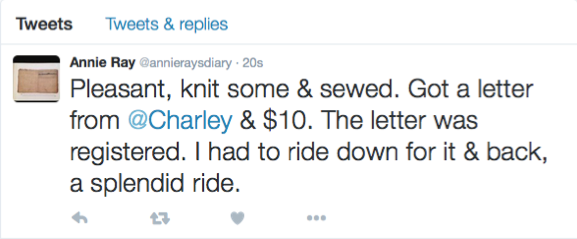I wrapped up my Life Writing classes in the Fall by asking my students to consider the relationship between historical genres like diaries and letters, and contemporary social media. One group of students, working on Twitter, conveyed their understanding of the links between past and present forms of self-representation by creating a Twitter profile for one of the historical diarists we had studied this semester, Annie Ray (whose diary is reprinted in Jennifer Sinor’s The Extraordinary Work of Ordinary Writing). Ray is an exemplary “ordinary” diarist: recording her experiences in spare, fragmented language. Or, as my students noted: precisely the kind of writing required by Twitter’s 140 character limit:

What my student’s didn’t know when they undertook this exercise is that there are several other Twitter accounts set up to reproduce historical diaries. I’ve written before about @TrapperBud, which was publishing Bud Murphy’s diary account of his gold rush experiences, and has now moved on to Matt Murphy’s diaries, dated from the 1920s.
Here are some others:
Samuel Pepys: @samuelpepys
Fanny Burney: @francesburney
John Quincy Adams: @jqadams_MHS
Genevieve Spencer: @Genny_Spencer
Andy Warhol: @warhollives
I am sure there are more, but these are the ones I’ve run across.
So, what are we to conclude from these Twitter accounts? Obviously, they do precisely what my students intended @annieraysdiary to do: they show that diaries and Twitter are closely aligned in form and content, essentially that Twitter can be considered a modern incarnation of the diary. Of course, they also show the differences, because more “literary” diaries with long reflective entries are not easily adaptable to Twitter. Rather, we see that one kind of diary (the “ordinary” kind, to use Sinor’s terminology) is being carried into the present through Twitter technology. Also, these Twitter accounts have a particularly playful quality because they invite the reader into the pretense that the historical diarist is tweeting her/his experiences directly. I think this makes the Twitter/historical diary mash-up unique. (There may be Facebook accounts written from the perspective of historical figures? I’m not on Facebook so I cannot verify this, and a little lite googling didn’t lead me anywhere.) As my students noted, there is something wonderful about imagining a historical figure like Annie Ray taking up her smart phone to record her life, just as so many of us do today.
For more:
Sean Munger, “How to be a historical figure on Twitter”
I wonder about the impact of the ephemeral nature of many digital platforms– especially Twitter. The Library of Congress planned a Twitter archive five years ago, but unless I gave missed an update (entirely possible), it us not up and running yet: http://www.michaelzimmer.org/2015/07/06/the-twitter-archive-at-the-library-of-congress/. Are the writings of diarists being lost? Platforms and methods of digital preservation come and go, and with them, immigrated data.
LikeLike